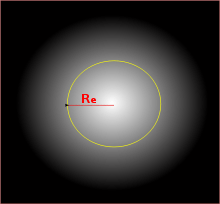Effective radius
The effective radius or half-light radius () of a galaxy is the radius at which half of the total light of the system is emitted.[1][2] This assumes the galaxy has either intrinsic spherical symmetry or is at least circularly symmetric as viewed in the plane of the sky. Alternatively, a half-light contour, or isophote, may be used for spherically and circularly asymmetric objects.

Half light radius Re encloses half of the total light emitted by an object
is an important length scale in de Vaucouleurs law, which characterizes a specific rate at which surface brightness decreases as a function of radius:
where is the surface brightness at . At ,
Thus, the central surface brightness is approximately .
See also
References
- "Half-light Radius". Swinburne University. Retrieved 22 May 2013.
- Binney, James; Tremaine, Scott (2008). Galactic Dynamics (Second ed.). Princeton Series in Astrophysics. p. 21. ISBN 9780691130279.
This article is issued from Wikipedia. The text is licensed under Creative Commons - Attribution - Sharealike. Additional terms may apply for the media files.